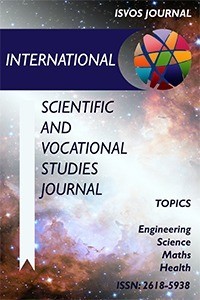Matrix Pencil Method and Singular Value Decomposition Application for DOA Estimation Using Linear Antenna Array with Multiple Signal Sources
matrix pencil, singular value decomposition, array signal processing, doa estimation, linear antenna array
Matrix Pencil Method and Singular Value Decomposition Application for DOA Estimation Using Linear Antenna Array with Multiple Signal Sources
matrix pencil, singular value decomposition, array signal processing, doa estimation, linear antenna array.,
___
- A. Paulraj, B. Ottersten, R. Roy, A. Swindlehurst, G. Xu, T. Kailath, “Subspace methods for directions-of-arrival estimation,” Handbook of Statistics, Elsevier, vol. 10, pp. 693-739, 1993.
- G. Yong, X. Ci, Z. Zong, “Erasing false-location of two stations direction-finding cross location in multi-path and multiple sources environments,” Radar, CIE International Conference on Proceedings, 2001.
- J. Capon, “High resolution frequency wave number spectrum analysis,” Proc. 1EEE 57, pp. 1408-1418, 1969.
- J. P. Burg, “Maximum entropy spectral analysis,” Ph.D. thesis, Stanford University, Stanford, CA, 1975.
- V. F. Pisarenko, “The retrieval of harmonics from a covariance function,” Geophys. J. Roy. Astronom. Soc. vol. 33, pp. 347-366, 1973.
- R. O. Schmidt, “Multiple emitter location and signal parameter estimation,” Proc. RADC Spectrum Estimation Workshop. Griffiss AFB, NY, pp. 243-258, 1979.
- G. Bienvenu, L. Kopp, “Principle de la goniometrie passive adaptive,” Proc.7’eme Colloque GRESIT. Nice, France, pp.1-10, 1979.
- A. Paulraj, R. Roy and T. Kailath, “Estimation of signal parameters via rotational invariance techniques- ESPRIT,” Proc. 19th Asilomar Conf. on Circuits, Systems and Computers. San Jose, CA, November, pp. 83-89, 1985.
- A. Paulraj, R. Roy and T. Kailath, “A subspace rotation approach to signal parameter estimation,” Proc. IEEE 74(7), pp. 1044-1045, 1986.
- R. Roy, T. Kailath, “ESPRIT- Estimation of signal parameters via rotational invariance techniques,” IEEE Trans. Aeoust. Speech Signal Process. vol. 37(7), pp. 984-995, 1989.
- M. Viberg, B. Ottersten, T. Kailath, “Direction of arrival estimation and detection using weighted subspace fitting,” Proc. 23rd Asilomar Conf. on Signals, Systems, and Computers, San Jose, CA, November, pp. 604-608, 1989.
- B. Ottersten, M. Viberg, T. Kailath, “Analysis of subspace fitting and ML techniques for parameter estimation from sensor array data,” IEEE Trans. Signal Process, vol. 40(3), pp. 590-600, 1992.
- L. Sibul, “Application of singular value decomposition to adaptive beamforming,” Acoustics, Speech, and Signal Processing, IEEE International Conference on ICASSP, USA, 1984.
- Y. Hua, T.K. Sarkar, “Matrix Pencil method for estimating parameters of exponentially damped/undamped sinusoids in noise,” IEEE Transactions Acoust. Speech, Signal Process. vol. 38 (1), pp. 814-824, 1990.
- T. K. Sarkar, O. Pereira, “Using the matrix pencil method to estimate the parameters of a sum of complex exponentials,” IEEE Antennas and Propagation Magazine, vol. 37 (1), pp. 48-55, 1995.
- T. K. Sarkar, N. Yilmazer, M. Salazar-Palma, “DOA Estimation using Matrix Pencil and ESPRIT methods using single and multiple snapshots,” Electromagnetic Theory (EMTS), URSI International Symposium, Berlin, Germany, 2010.
- M. Ihedrane, S. Bri, A. E. Fadl, “2-D Matrix pencil for doa estimation,” International Conference on Wireless Technologies, Embedded and Intelligent Systems (WITS), 2019.
- N. Aytaş, E. Afacan, N. İnanç, “The Application of Matrix Pencil Method for Direction Finding Using a Linear Antenna Array,” 29th Signal Processing and Communications Applications Conference (SIU), pp. 1-4, 2021.
- ISSN: 2618-5938
- Yayın Aralığı: Yılda 2 Sayı
- Başlangıç: 2017
- Yayıncı: Umut SARAY
Analysis of Factors Affecting Density of Vaccine Centers by Fuzzy ELECTRE I Method
Merve ALTUNAY, Mustafa AKKAŞ, Özge GÖY
Learning Based Super Resolution Application for Hyperspectral Images
Ayşenur KAHRAMAN, Ayşe ÇATALOLUK, Özgür ALPARSLAN
Design of Electrical Test Device for Automotive Industry
Kadir VARDAR, Fırat AYDEMİR, Durmuş ÖZDEMİR, Mustafa TOPUZ, Burakcan KOLAY, Yusuf YILDIRIM, Zehra BİLİCİ, Mustafa Uhud BAYDOĞRUL, Yunus Emre YAĞAN, Bünyamin KAYA, Ali TANDOĞAN, Ethem Yiğit GÜRER
Machine Learning Based Short Term Load Estimation in Commercial Buildings
